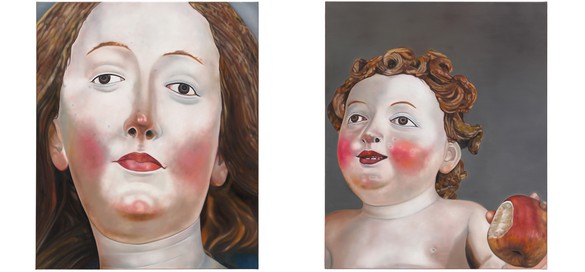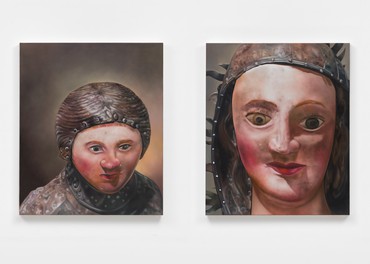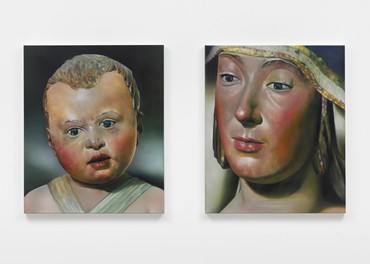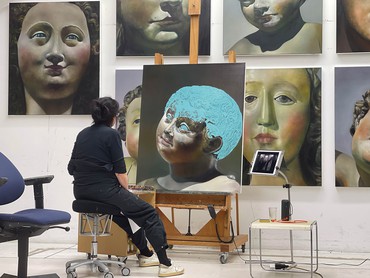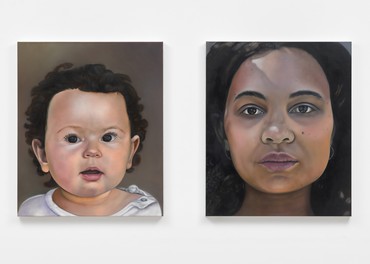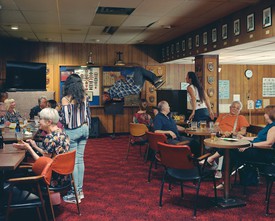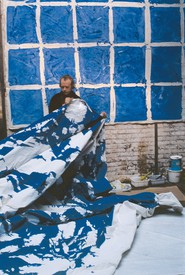
Ulrich Wilmes is a curator, editor, and writer. Previously deputy director of the Museum Ludwig, Cologne, and chief curator at the Haus der Kunst, Munich, he has published numerous books and articles on contemporary art.
What you see is my view of the world. I don’t want to depict real moments, but everything in the picture should be plausible and function as a pictorial reality.
—Karin Kneffel, 2022
With twelve new diptychs of women and children, Karin Kneffel has ventured into two fields of which she had always been wary: portraiture—with few exceptions, people had not previously featured in her imagery—and vertical format of medium scale. Each painting shows a woman’s face, closely framed, and the head of a child. In terms of both content and form, then, the artist faced a challenge.
Kneffel never uses titles, leaving viewers to their own devices. However, given that she derived most of these portrayals of heads from painted sculptures, the reference to those objects overlays the observation that we are looking at a series on the theme of the woman and child. Although this phrase might serve as a general term for the series, it is not yet an adequate interpretation of their content, not least because the ten diptychs based on historical artifacts are joined by two contemporary portraits. Of particular interest is Kneffel’s first-ever self-portrait, which also shows her son; the other work depicts a mother and child from the artist’s inner circle.
Kneffel’s realism appeals to a “seeing” viewer who not only recognizes the objects depicted in the painting but who also views the painting as the result of a “phenomenal description” that forms “the foundation of a particular meaning that cannot be formulated any other way.”1 This distinction between “seeing” and “recognizing” was introduced by the art historian Max Imdahl as a key element of the analytical method he called “iconism.” In his approach, these two ways of seeing merge in an act of visual appropriation: “In iconic viewing, or iconism, the picture becomes accessible as a phenomenon in which the objective, recognizing view and the formal, seeing view mediate each other, giving access to a higher order and totality of meaning that both includes and surpasses the practical experience of seeing.”2
This “difference between reality and what the picture shows,”3 in Kneffel’s words, is precisely the focus of her painting: “The reality of a picture is one reality, the reality of life another. There should be no doubt about this.”4 Over the years, the relationship between Kneffel’s works and reality has developed into a highly complex cosmos in which many visible layers appear to intertwine. By contrast, these new paintings take us back to her work of the early 1990s, where no multiple reflections or fogged-up windows veil our view of the subject. The small-format pictures of animals that Kneffel also made at that time, showing cropped heads against neutral backgrounds, are thematically quite different from the new works but are comparable in structure. By engaging in these portrayals, with their characteristic individual physiognomies, Kneffel dealt with her anxiety about human portraiture, a genre she had felt unable to tackle at that stage in her career: “I’m interested in the theme of the portrait but painting people struck me as too complicated, too psychological, and vain, and there was also the struggle for resemblance. Which is why I chose domestic pets that everyone knows. For me, making portraits of animals involved defamiliarizing my interpretation of the animal, as well as my visual habits and prejudices.”5
Although the new pictures share an apparently simple template, like all of Kneffel’s paintings they reveal various, more complex layers of “reality.” Each layer has its own figurative and visual properties, which align in the painting. It is through process that we “see” the actual picture.
The process began with sculptures in painted wood from the fourteenth through the sixteenth century. Kneffel’s view of these diverse works enhanced her fictions about their contemporary relevance as historical artifacts. What interests her, as a contemporary artist, about this religiously and art-historically charged motif is not otherworldly ecstasy but worldly existence. The skillfully executed sculptures she chose reveal an unusual degree of subjectivity on the part of the artists who made them. The resulting realism is at odds with the notion of supernatural perfection aimed for by Renaissance masters in their portrayals of the Madonna. Instead, the marked facial traits of these “women” evoke the real-world model on which each wood-carver based his work. Accordingly, one feels invited to speculate on the relationship between each model and each artist. Her status as companion or muse, perhaps with a romantic attachment, is impossible to prove; but the theory of a close, perhaps familial relationship is supported by one conspicuous fact: to varying degrees, an emphasis is evident throughout on the resemblance between woman and child. And this resemblance provides an important point of departure for Kneffel’s work.
Over time, Kneffel photographed these sculptures wherever she found them, building up an archive of images that she would eventually work into paintings. Photographs are the ambivalent originals on which most of her paintings are based. Here, the transformation of a solid object into the two-dimensionality of the picture plane begins a distancing process that is central to her concept, creating an added pictorial layer and inserting it between the reality of the original artifact and its representation. In turn, this distance enables a more intimate approach to the essence of the sculptures themselves.
Kneffel photographed the ten woman-and-child motifs in close-up. Rather than showing the whole figure, she focused tightly on a small section, showing the woman’s face and the child’s head. She then departed from the originals by arranging her depictions of woman and child on separate canvases, and almost always in such a way that their eyes don’t meet.
Converting photographs into paintings necessarily increases the distance between subject and image by rendering the connection between the two unclear. In and of itself, the painting process challenges the picture’s bearing on the reality of the subject. Because Kneffel’s paintings are abstractions of real objects, existing mental images and the various psycho-physiognomic interpretations that they evoke intervene constantly in the viewing experience.
The sculptures and their layers of paint are executed in very different styles, all to exacting standards of craftsmanship. The treatment of their surfaces in particular has a delicate smoothness that flatters Kneffel’s painting style in the transference from one medium to another. Basing the paintings on photographs fosters both tactile creation and the contemplative experience of a homogenous surface. This reflex is intensified in the experience of the paintings, but the traces of historical aging processes are not erased, even if they are smoothed by the slight blur in which the paintings are bathed.
The face of each “woman” is expressive in a specific way, showing a similarity with the face of the corresponding “child.” Isolating the portraits on separate canvases gives this resemblance the air of a kind of profane devotion. The presence of such similarities, clear to a greater or lesser degree in most of the portraits, was evidently a criterion in Kneffel’s selection process.
Further features are worth noting: in most of the paired portraits the shape and position of the eyes, with their finely drawn brows, are almost identical. In one pair the traits that determine facial appearance are rendered with special delicacy—wide-open eyes, smiles hovering around the corners of the mouths, noses with straight, slender bridges and slightly upturned tips—revealing striking similarities that offer irrefutable proof of the mother-child relationship and lend the faces a sympathetic approachability.
Ruddy, applelike cheeks are a shared attribute in some portraits, imparting a layer of sweetness. This effect is heightened by the boy’s smile, whereas the mother looks down on the viewer with a self-assurance that borders on pride. Generally, the sightlines of the two figures run in different directions, except in one case where the mother’s eyes seem to meet those of the boy, who looks up at her from the right. This diptych also differs from the others in that the mother’s and child’s faces do not share a strong resemblance, despite the diagonal gaze that binds the two canvases into a single compositional unit.
Another diptych is unique in the series for a different reason: while the subjects of the other portraits have well-proportioned features, here the faces of both mother and child are unsightly, giving an impression of imperfect workmanship on the part of the sculptor. With their lack of symmetry, the faces appear strangely distorted, almost comical. Their eyes gaze blankly into a void, seeming entirely detached. Perhaps this sculpture originated in a folk religion, where it was revered in a specific context. The figures’ shapelessness is underpinned by their crude garb, which frames the faces in what looks like chain mail.
The vividly rendered facial resemblances in these paintings appear as a result of the direct relationship, human and physiognomical, between mother and son. This raises the question of the sculptor’s model, and of the artist’s ties to the woman and child in the picture.
Both by nature and by comparison with the other works, the painting of the living mother and daughter and Kneffel’s self-portrait with her son appear thoroughly contemporary. They feel more true, for their appearance presents a more direct link between pictorial and empirical reality. The path from recognizing the subjects to understanding their portrayal seems considerably shorter. The layering of reality is reduced, leading from model to photograph to painting. The women’s faces loom against dark backgrounds while the children are depicted as busts. And now the figures gaze in the same direction. The subjects of Mutter und Kind are both seen frontally, their eyes fixed firmly on the viewer; the heads in Selbstporträt mit Sohn are in different positions, the woman looking diagonally down at the boy, who is shown in three-quarter view and whose gaze is also directed downward.
The two portraits speak of very different relationships between the two figures. The frontal, side-by-side arrangement of the first pair gives little clue as to the tie between woman and child, since their gazes do not connect but are directed in parallel out of the picture plane. Kneffel’s self-portrait suggests a connection, as she looks down at her son, but the status of the relationship seems ambivalent. Both works display a convincingly human relationship between woman and child, situating them within the lived reality of today, as opposed to the pictures based on historical artifacts.
Kneffel’s paintings are based on painted wooden sculptures of the Virgin Mary. The Madonna and Child is one of the most distinguished topoi in Western art history, playing an important role in the development of the worship of Mary as the mother of God—a title acknowledging the central doctrine that Jesus Christ is both truly divine and truly human. The Virgin has been worshiped since the early days of Christianity and is a key element of the popular Christian faith, which appeals to Mary as an intermediary between God and humans during their time on Earth.
These theological factors, however, played no part in either the concept for the series or the selection of the sculptures. Nor did Kneffel seek out or choose these artifacts on the basis of their art-historical significance, although the history of painting is among her key concerns: “I am always interested in the historical aspect of painting, and that is also how I approach portraiture. An unbiased approach to this subject is not really possible. Our visual habits are shaped by art history.”6 Kneffel’s formal dissolution of the mother-child unit in the original sculpture by separating them onto two canvases acts as a corrective to the relationship between imagined narrative and objective reference.
The originals on which Kneffel’s series is based are linked by chance—she discovered them all in places she visited while traveling. Each of these found objects contains traces of a specific personal reality, its appearance revealing a subjective interpretation of the mother-and-child motif. The paintings focus on the “human” dimension inherent in the figure of the mother of God. Kneffel takes the unquestioning, unconditional surrender of one’s fate to divine providence, and the conventional role of the servile, silent woman as mother and educator, and places them within the reality of modern life. Tackling this theme is a mighty, seemingly impossible task; for a contemporary artist, the distance between rational knowledge and the existential spheres of transcendental faith would seem too great. The intrinsic accord that Kneffel identifies in this series makes mother and child appear as human individuals. And despite the spatial distance between the figures, this sense of humanity creates an emotional affinity between the viewer and the motif.
What fascinated Kneffel most about the Madonna portrayals was their distinctive traits. The emphasis on family resemblance that is identifiable to varying degrees in the faces of these women and children gave her a starting point, and in her artistic appropriations and transformations she foregrounded the humanity sensed by both the sculptors and the viewers of the sculptures. In her own paintings, Kneffel underscores this perceived connection to create a clear link between the timeless past and the present moment.
1Max Imdahl, Giotto. Arenafresken. Ikonographie, Ikonologie, Ikonik (Munich: Fink, 1980), p. 99.
2Ibid., pp. 92–93.
3Karin Kneffel, in Gabi Czöppan, “Ich wollte unbedingt malen,” H.O.M.E., October 2019.
4Kneffel, in an interview with Daniel Schreiber, 2010.
5Kneffel, in Czöppan, “Ich wollte unbedingt malen.”
6Kneffel, in the interview with Schreiber.
Karin Kneffel: Face of a Woman, Head of a Child, Gagosian, Via Francesco Crispi 16, Rome, November 11, 2022–January 14, 2023
Artwork © Karin Kneffel
